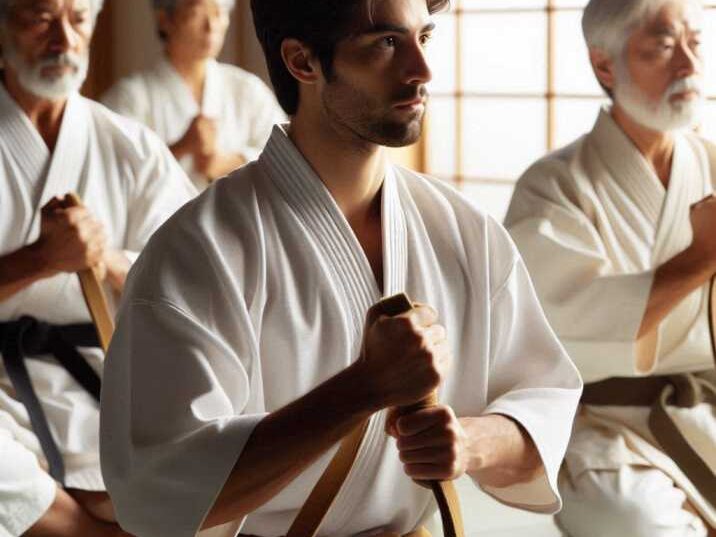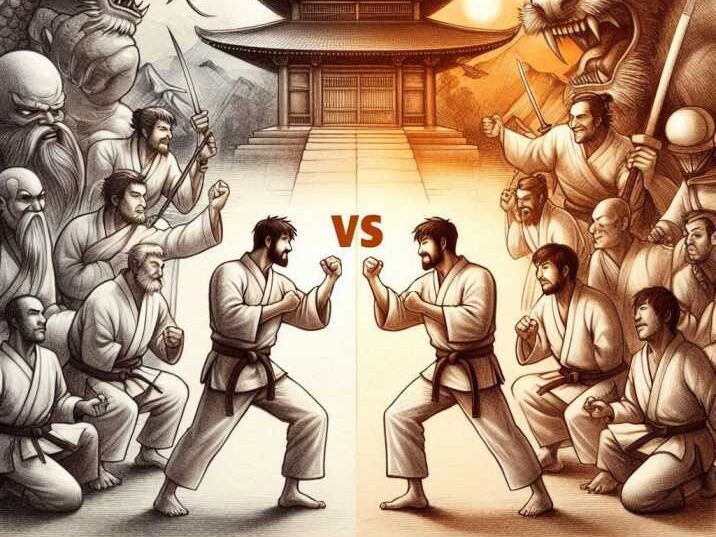Introduction
Table of Contents
From ancient customs to contemporary sports, martial arts have been practiced for thousands of years. While modern martial arts are affected by current requirements and training advancements, traditional martial arts are based on centuries-old techniques and ideas. Both forms call for discipline and attention, which are abilities that can help trainees become more focused in their daily lives as well as in their martial arts practice. The main distinctions between traditional and Modern martial arts will be discussed in this article, along with how they affect technique, training, and life skills.
1. What Are Traditional Martial Arts?
Traditional martial arts are ancient combat systems developed in various parts of the world. They are rich in history, culture, and philosophy. Some of the most well-known traditional martial arts include:
- Karate from Japan
- Kung Fu from China
- Taekwondo from Korea
- Judo from Japan

1.1 Emphasis on Philosophy and Discipline
A key component of traditional martial arts is discipline. Instructors, often called masters or sensei, place great importance on respect, honor, and self-control. Students are expected to follow strict codes of conduct both inside and outside the dojo.
1.2 Focus on Self-Defense and Personal Growth
While physical combat is part of traditional martial arts, the emphasis is on self-defense rather than aggression. Students are taught to only use their skills in life-threatening situations. The personal growth of the martial artist is just as important as mastering techniques.
2. What Are Modern Martial Arts?
Modern martial arts have developed to meet the needs of contemporary athletes and sports enthusiasts. These systems often borrow elements from traditional martial arts but are adapted to focus more on practical fighting and sport. Examples of modern martial arts include:
- Mixed Martial Arts (MMA)
- Brazilian Jiu-Jitsu
- Kickboxing
- Krav Maga
2.1 Focus on Competition and Fitness
Unlike traditional martial arts, modern martial arts emphasize competition. They are frequently seen in sports tournaments and matches. The goal is often to build fitness, agility, and combat skills, with less focus on philosophy and discipline.
2.2 Adaptable Techniques and Practical Combat
In modern martial arts, fighters adapt their styles based on the situation. There is a lot of flexibility in movements, unlike the rigid structures of traditional martial arts. For example, MMA blends various styles to create an effective fighting system that is adaptable in real-world combat scenarios.
3. Key Differences in Training and Techniques
3.1 Training Routines
Traditional martial arts emphasize katas or forms, which are prearranged sequences of movements. Students practice these forms repeatedly to perfect their techniques. In contrast, modern martial arts focus on sparring and real-time practice, allowing students to engage in combat with partners.
3.2 Equipment and Gear
Traditional martial arts use minimal gear, such as uniforms (gi), belts, and sometimes weapons like swords (katana) or staffs. Modern martial arts, especially those like MMA and kickboxing, use advanced protective gear such as gloves, shin guards, and headgear to prevent injury during combat.
4. Philosophy and Cultural Influence
4.1 Traditional Martial Arts: Deep Cultural Roots
Traditional martial arts are deeply tied to the cultures from which they originate. They often incorporate rituals, ceremonies, and meditation practices. For example, in Karate, bowing to the instructor and opponents is a sign of respect and humility.
4.2 Modern Martial Arts: Global Influence
In modern martial arts, there is less emphasis on rituals and cultural ties. The focus is primarily on the practical application of techniques and achieving fitness goals. However, modern martial arts still respect the core values of martial discipline, albeit in a less formalized way.
5. The Role of the Instructor
5.1 Traditional Martial Arts: Mentor and Master
In traditional martial arts, the instructor is seen as a master who passes down ancient wisdom and techniques. They are highly respected and are often considered as mentors who guide the student in both martial arts and life.
5.2 Modern Martial Arts: Coach and Trainer
In modern martial arts, the role of the instructor is more like that of a coach. They focus on training athletes to perform well in competitions. While respect is still important, there is less of a hierarchical structure compared to traditional systems.
6. Benefits of Martial Arts Training for Focus and Discipline
Both traditional and modern martial arts require a high level of concentration and discipline. These qualities are essential not only for learning the physical techniques but also for developing mental strength. The skills students acquire through martial arts training can benefit them in other areas of life, such as school and personal development. Let’s explore these key benefits in more detail:
Improved Concentration
Martial arts training often involves learning complex movements and techniques, whether it’s a structured form like a kata in traditional martial arts or a flexible sparring technique in modern martial arts. Mastering these movements demands intense focus and concentration.
For example, students need to remember multiple steps in the right order, maintain proper posture, and apply precise timing—all while staying aware of their surroundings and opponents. This level of focus can help students become more attentive in other areas of life, such as paying attention in class or completing homework assignments with fewer distractions.
Discipline
Martial arts teach students the importance of setting goals and working toward them with dedication and perseverance. Whether it’s earning the next belt rank or perfecting a specific technique, students learn that improvement requires consistent effort over time.
In both traditional and modern martial arts, there is a structured routine that students must follow, from warm-ups to cool-downs. By adhering to this routine, they develop strong habits of discipline, which can translate to everyday life. For instance, students may become more organized in completing tasks or sticking to a study schedule, which can lead to better academic performance.
Mental Toughness
Martial arts training isn’t just physically demanding; it also pushes students to develop mental toughness. In training, students often face challenges, such as learning a difficult move or recovering from a loss in a competition. These experiences teach them to stay resilient and not give up easily.
Learning to cope with setbacks and push through physical fatigue helps build mental strength. As a result, students who practice martial arts are more likely to handle stress and challenges in other areas of life, like facing difficult school projects or overcoming personal struggles. The mental toughness gained through martial arts can help students stay motivated and determined, even when things get tough.
Table of Information
| Aspect | Traditional Martial Arts | Modern Martial Arts |
|---|---|---|
| Philosophy | Focus on discipline, honor, respect | Focus on fitness, competition |
| Techniques | Predetermined forms (katas) | More flexible, adaptable moves |
| Training Goals | Personal growth, self-defense | Competition, sport performance |
| Use of Equipment | Minimal, traditional gear | Extensive use of modern gear |
| Forms/Patterns | Emphasis on structured routines | Emphasis on practical combat |
| Instructors’ Role | Viewed as mentors, figures of authority | Seen as coaches or trainers |
| Cultural Influence | Deeply tied to culture and rituals | Less focus on cultural traditions |

Conclusion
Whether you choose traditional or modern martial arts, both offer valuable lessons that go beyond physical combat. While traditional martial arts focus on philosophy, discipline, and self-defense, modern martial arts are geared more towards competition, fitness, and practical combat. Both types of martial arts help build focus, discipline, and mental toughness, skills that can be applied to all aspects of life, from school to sports.
FAQs
- What are traditional martial arts?
Traditional martial arts are ancient fighting systems that focus on discipline, respect, and self-defense. - What are modern martial arts?
Modern martial arts are combat styles developed for sport, fitness, and practical fighting, such as MMA and kickboxing. - Which is better: traditional or modern martial arts?
It depends on your goals. Traditional martial arts focus on philosophy and self-defense, while modern martial arts emphasize fitness and competition. - Do martial arts improve focus?
Yes, both traditional and modern martial arts require concentration and discipline, which can improve focus in school and other activities. - Is there a lot of equipment in modern martial arts?
Yes, modern martial arts often use protective gear like gloves and headgear, while traditional styles use minimal equipment.


